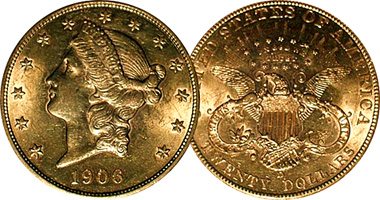

This is a beautiful coin. The old Liberty $20 double eagles contain almost one troy ounce of gold (0.9675 ounces, precisely). If, say, the current 'spot' value of gold is $1000 US dollars per troy ounce, this coin is worth at least $967, or 0.9675 x 1000 = 967. The price of gold changes every day, so look up the current price at kitco.com. When looking up gold or silver, remember that 'troy ounces' and 'ounces' are the same thing; the word 'troy' is understood.
You can easily compute the Base Value (BV) of these coins by multiplying the current gold price by 0.9675.
There is an addition of value over the basic gold value due to the fact that your coin is more than gold bullion, it is a piece of numismatic artwork and is part of US history. So don't buy this coin strictly for investment in gold. It's more than that. But be careful. If you are not a seasoned coin collector, you can easily be snookered by a smooth-talking gold salesmen.
Typical auctions on eBay, with a reputable seller and lots of bidders, bring $100 US dollars or more over BV. So adding $100 to the current BV gives you a good ballpark value for most $20 gold pieces. Sometimes the $100 added value can reach toward $1000 or higher if the coin is in superb condition. Here is a rule of thumb for most common dates (see listing below for special dates):
worn: add $50 to the BV
average circulated: add $100
well preserved: add $250
fully uncirculated: add $400
The discussion above indicates how the value of these coins starts at the basic gold value (BV) and climbs as condition of the coin improves. The resulting value is a retail value, what a collector would pay. If you have a coin to sell, figure that a coin dealer would offer you substantially less than retail. A 10 to 30 percent markup would not be unreasonable for a single coin, so a dealer might offer you 10 to 30 percent less than retail. If you have lots of coins to sell, a dealer would probably lower the percent markup.
If you have a nice looking example of this coin, or if you are unfamiliar with coin grading terms such as AU50 and MS64, seek out a knowledgeable collector or professional coin dealer for an in-person appraisal.
Coin grading makes a big different in these coins. For instance, an 1877 Liberty double eagle $20 gold piece in a PCGS holder graded MS64 catalogs around $15,000. The same coin in average circulated condition with no PCGS holder catalogs near $1500. PCGS is one of several companies that accurately grades coins. The other reliable ones are NGC, ICG, and ANACS. Do not use other grading companies. Obviously, don't spend money for high grade coins unless you know for sure that the coin truly carries a high grade. It usually takes many years for coin collectors to learn how to grade coins. If you have no idea how to do this, don't buy high grade coins from someone you do not trust implicitly.
This all sounds confusing, and it is. Don't spend a lot of money on these coins unless you know what you are doing. It is a complicated subject. Further, fakes are possible (see this page).
If you are thinking about investing in gold, and you are not a numismatist (coin collector), a much safer bet is found at this CoinQuest Link.
NEVER CLEAN A COIN. CLEANING RUINS VALUE.
All the dates of these coins are worth about the same, except as discussed next. Look on the back of the coin, under the eagle. You may see a blank space there, or an S, and O, or a doubled C (CC). This is the mint mark. Coins with a blank space were minted in Philadelphia. S means San Francisco, O means New Orleans, and CC means Carson City, Nevada.
There are certain dates and mint marks which carry significantly more value than common-date coins. The list below shows added value over basic gold value for coins in average circulated condition.
1854O: add $25000 to basic gold value (BV)
1855O: add $2500
1856O: add $35000
1858O: add $400
1859O: add $2000
1860O: add $2000
1861O: add $1000
1970CC: add $70000
1871CC: add $2500
1872CC: add $400
1879CC: add $500
1879O: add $2500
1881: add $3000
1882: add $5000
1885: add $6000
1885CC: add $400
1886: add $6000
1891: add $2200
1891CC: add $1200
1892: add $500
If your coin is not in the list above, use the rule of thumb discussed first. As you can see, evaluating these coins in a complicated matter. It is best to get and in-person appraisal no matter what the date and mint mark of your coin, but it is especially important if your coin is in the list of special dates above.
cqLastNotify
About CoinQuest | Privacy Policy | Contact CoinQuest
Copyright 2009 to 2024 CoinQuest.com, all rights reserved.
Daily visitors 155, minutes per visit 5.4, daily coin views 349